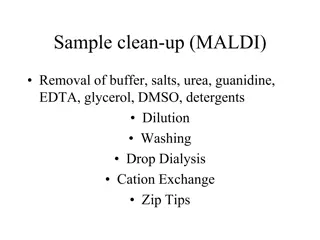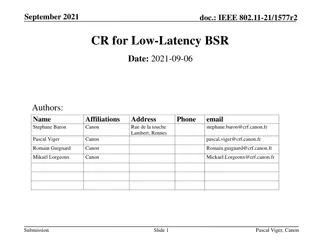Understanding Buffer Solutions: Properties and Applications
Buffer solutions are essential in resisting pH changes and consist of mixtures of weak acids or bases with their salts. They maintain constant pH levels despite dilution or addition of acids/bases. Buffer capacity measures the amount of acid/base needed for a pH change. Biological systems and pharmaceutical applications also utilize buffer solutions for maintaining specific pH levels in various fluids.
Download Presentation

Please find below an Image/Link to download the presentation.
The content on the website is provided AS IS for your information and personal use only. It may not be sold, licensed, or shared on other websites without obtaining consent from the author. Download presentation by click this link. If you encounter any issues during the download, it is possible that the publisher has removed the file from their server.
E N D
Presentation Transcript
LESSON 2 BUFFER SOLUTIONS The solutions that are able to resist the changes in PH are called buffer solutions. Buffer solution consist of mixture of weak acid and its salt or a weak base with its salt Types: Acidic buffer solution: Solutions having a mixture of weak acid (acetic acid) and its salt(sodium acetate) Basic buffer solution: Solution having a mixture of weak base(NH4OH) and its salt(NH4Cl)
Properties of buffer solutions: Ph of buffer solution remain constant on keeping for long time Ph of solution does not change on dilution Ph doesn t change even on addition of small quantities of acids and bases. Buffer action: The resistance to change in ph is called buffer action Buffer capacity(buffer index, buffer value, buffer efficiency) It is the amount of acid or base that must be added to buffer to produce unit change of ph
B= small increment in gram equivalent per liter of strong base added to buffer solution to produce ph change of . Buffer capacity has a value of 1 when the addition of 1 gram equivalent of strong base to 1litre of buffer solution result in change of 1 ph unit Buffers in biological systems: Blood: It has ph 7.35-7.45 which is primary buffer in plasma and secondary buffer in erythrocytes. Plasma has carbonic acid/bicarbonate buffer and acid /alkali potassium salts of phosphoric acid Lacrimal fluid or tears: It has ph 7-8 Urine: It averages about 6 units i.e., 4.5-7.8 If ph is below normal values ,H+ are excreted by kidneys If ph is above normal value ,H+ are retained by kidneys
Pharmaceutical buffers: Standard buffer solutions are of standard ph .They are used for reference purpose in ph measurement and carrying out specified tests to maintain specific ph. Eg., HCl buffer (ph - 1.2 - 2.2) Acid phthalate buffer (PH- 2.2 - 4.0) Neutralized phthalate buffer (Ph - 4.2 - 5.8) Phosphate buffer (Ph 5.8 - 8) Alkaline borate buffer( ph 8.0-10.0)

















































